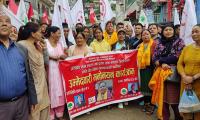Valg i Nepal er tegn på demokratisk fremgang
The forthcoming general election demonstrates that the democratic trajectory for Nepal has been moving towards a positive direction since the last People’s Movement in 2006.

On the 20th of November 2022 Nepal will hold general elections. The election is a sign of how far the country has come since the signing of the Comprehensive Peace Agreement (CPA) committing the country to democracy and peace for the progress of the people.
Shrishti Rana, DIPD’s Country Representative in Nepal, believes that the upcoming election is crucial for the continuing democratic development in Nepal.
To understand the significance of the elections in Nepal, it is important to include the democratic developments of the country and the political context.
A long difficult struggle for democracy
The democratic history of Nepal is long and difficult. In the early 1950s the first movements for democracy started with support from the then monarch of Nepal. This led to a new constitution, and the first democratic election for a house of representatives. In 1960, a new king took over and dismissed the first democratically elected government.
During 1990 and especially in 2006 the great People’s Movement paved the way for a multiparty democracy. The years between was a bloody decade of civil war, with fighting between the royal government and the Communist Party of Nepal.
After the 2006 movement, the king resigned from his power and reinstated the parliament. The peace agreement was signed along with a new constitution, which was promulgated in 2015.
“One of the main goals of the new constitution is to institutionalise multiparty democracy in Nepal through regular periodic elections at local, provincial, and federal levels. Shortly after the new constitution was promulgated in 2015, Nepal had elections at all the three levels,” Shrishti Rana explains.
A political transition
DIPD has worked in Nepal in partnership with the multiparty platform, Joint Mechanism for Political Party Strengthening, (JOMPOPS) since 2012 supporting the country on its path towards a more stable democracy.
JOMPOPS initially focused on strengthening multiparty collaboration among political parties to support the finalisation of Nepal’s new constitution. The multiparty approach is important as the Nepalese transition into a fully functional multiparty democracy reflects Nepal’s vast social and ethnic diversities well in the different governance tiers and structures of Nepal’s more than 100 ethnic groups.
“The greatest challenges for democracy in Nepal are the need to address its immense diversity as well as to deliver on economic progress demanded by the people. It is not an easy task for a young democracy” Shrishti Rana states.
Younger mayors being elected
As in many other countries, the key focus of the forthcoming elections in Nepal are unemployment, health, and education. The population are demanding that the politicians deliver through economic progress.
Shrishti Rana explains: “In the local elections this summer, we saw people’s desire for new ways of politics reflected in their choosing of some young mayors. This trend may continue in the federal and provincial elections.”
The focus on younger politicians has also been supported by the Danish Social Liberal Party (Radikale Venstre), who has worked in partnership with JOMPOPS, emphasizing the inclusion of youth in politics.
Still a way to go
Nepal’s political system is emerging out of a long political transition, and it is important to safeguard the political gains that have been possible as a result of several people’s movements and campaigns for multiparty democracy.
“For the Nepalese people, these regular peaceful elections are a great progress forward given our challenging democratic history. Having said this, elections themselves are not adequate for vibrant and fully functional democracy. Nepal still has a long way to go before it becomes a mature stable democracy that delivers for its people.” Shrishti Rana says.
This page is also available on the english site. Click on english in top menu.



